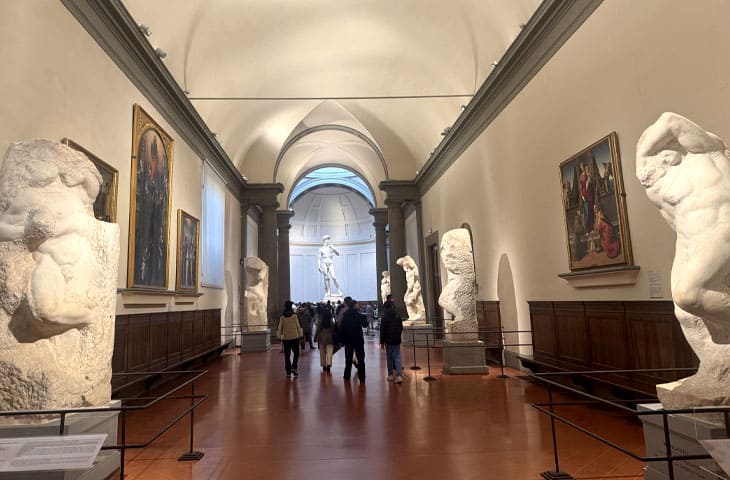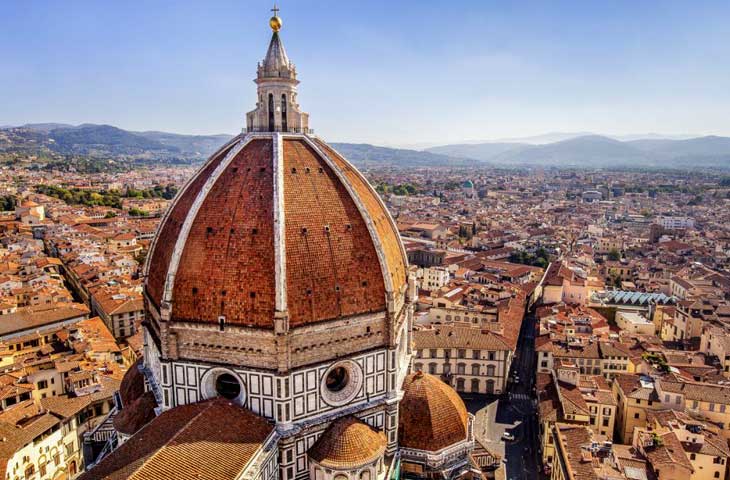Co vidět v galerii Accademia ve Florencii
The Galerie Accademia je jedním z nejvýznamnějších muzeí v Florencie, s uměleckými a sochařskými mistrovskými díly vůd renesanční umělci, včetně fantastických David od Michelangela.
Historie galerie Accademia ve Florencii
The Galerie Accademia byl zahájen velkovévoda Leopold Lotrinský v 1784 v tom, co bylo dříve San Matteo NEMOCNICE a Sklášter Niccolò di Cafaggio. Chtěl propagovat Akademie výtvarných umění ( Accademia di Belle Arti ) líbí Cosimo de' Medici udělal v 1500s. Měl být místem, kde by se studenti výtvarného umění mohli inspirovat mistrovskými díly velkých renesančních umělců, a také výstavou uměleckých odlitků a modelů.
V 19 století, po uzavření mnoha konventů a klášterů Napoleon, k tomu byly přivedeny další obrazy a sochy Muzeum. Jednalo se především o náboženská díla, často charakteristická zářivě zlatým pozadím.
The Galerie Accademia ve Florencii Galerie je jedním z nejvýznamnějších muzeí florentského renesančního malířství, pokrývající období od 13. století do konce 16. století.
Navštivte galerii Accademia ve Florencii

Také známý jednoduše jako akademie, Galerie je blízko Piazza San Marco. Hlavní vchod se nachází na Přes Ricasoli, jen pár bloků od Florentská katedrála.
Je těžké si nevšimnout dlouhých front návštěvníků čekajících na vstup a obdivování nádherných uměleckých mistrovských děl zachovaných ve dvou patrech tohoto Muzeum.
Sál Colossus of the Accademia
První místnost, do které v muzeu vstoupíte, je Kolosový pokoj. Název pochází ze sádrové reprodukce části Dioscuri socha z Montevallo. Sousoší je umístěno uprostřed kašny v Piazza del Quirinale v Římě. Představuje syny Zeus, Castora Pollux, a uprostřed je také obelisk. Kopie zůstala v akademie až do počátku dvacátého století, než byl převezen do sádrové galerie v Liceo Artistico di Porta Romana v Florencie.
Ve středu místnosti místo toho kopie „Znásilnění sabinských žen“od Giambologna, považovaný za oficiálního sochaře rodu Medici, stojí. Přes italizované jméno to byl vlámský umělec Jean de Boulogne. Původní socha se v tomto případě nachází pod Loggia dei Lanzi na náměstí Piazza della Signoria.
Stěny Kolos pokoj vystavit obrazy z patnáctého a šestnáctého století, včetně děl Paolo Uccello, Sandro Botticelli, Perugino, Ghirlandaioa Filippo Lippi.
Síň vězňů
The Sala dei Prigioni (nebo Síň vězňů) je další důležitou místností v Galerii Accademia. Jeho název pochází ze čtyř nedokončené sochy vězňů (nebo otroci), kteří měli být součástí slavné hrobky Papež Julius II, ale nebyly nikdy dokončeny do Michelangelo.
The Sala dei Prigioni (Síň vězňů), dlouhý a úzký, vděčí za svůj název nedokončeným sochám od Michelangelo, původně určeno pro hrob o Julius II della Rovere v Bazilika San Pietro. Projekt byl přerušen kvůli nákladům a obrovské práci s tím spojené. Součástí mauzolea mělo být přes 40 figurek na různých úrovních.
Michelangelo původně uvažovalo o opětovném použití Prigioni (Vězni) sochy k ozdobení Mojžíše z kostela San Pietro ve Vincoli v Římě s úmyslem symbolizovat duše uvězněné v tělech. Nápad však opět nevyšel. Po umělcově smrti byly sochy darovány Rodina Medici. Jejich architekt Buontalenti nakonec je uspořádal v Grotta Grande Zahrady Boboli. Postupem času se Prigioniho sochy zhoršila, tak in 1908 byly trvale umístěny v Galerie Accademia ve Florencii
Vězení aneb Slaves of Accademia Gallery ve Florencii

Původně mělo být dvacet Prigioni (Vězni), s rysy vězňů připoutaných a opřených o základnu sloupů. Snad jejich účelem bylo narážet na provincie, které ovládají Papež Julius IInebo představovaly alegorii všech umění.
Popravený Prigioni ne všechny mají stejný povrch nebo dokonce stejnou úroveň umění, což je důvod Michelangelolze odvodit pracovní techniku. Raději začal od přední části díla a poté pokračoval příčně.
V Galerie Accademia ve Florencii, čtyři ze stávajících šest Prigioni (Vězni) jsou umístěni. První dva že Michelangelo vyřezávané představují Umírajícího otroka a Rebel Slave, a jsou prakticky hotové, ale abyste je viděli, musíte jít do Louvre v Paříž.
The Prigioni (Vězni) se proto také nazývají Otroci protože se jeví jako mocná mužská těla uvězněná ve skále. V hale Galerie Accademia ve Florencii, tyto sochy jsou uspořádány ve dvojicích podél bočních stěn a střídají se s dalšími podobnými díly.
The Galerie Accademia ve Florencii je muzeum, které uchovává mnoho z nich Michelangelomistrovská díla. Zde lze obdivovat Mladý otrok, Vousatý otrok, Probuzení otrokaa Atlas.
San Matteo od Michelangela na Accademia
V Sala dei Prigioni (Síň vězňů ), existuje také San Matteo, další dílo od Michelangelo. Projekt měl v tomto případě vše vytesat 12 apoštolů pro Florentská katedrála. Umělec však musel zakázku znovu opustit, aby mohl jít Řím a řídit se dalšími úkoly. Jedinou částečně dokončenou sochou je tedy socha o San Matteo.
Pietà of Palestrina na Accademia

Než věnovat veškerou pozornost Michelangeloje skvělý Davide, nesmíme zapomenout na Pietu Palestrina. Na rozdíl od ostatních umělců Pietàs, neživé tělo Ježíši Kriste je podporována oběma Panna Maria a Svatý Jan a Evangelista.
Na přiřazení této sochy by se však dalo mnoho věcí zlepšit Michelangelo. Někteří vědci tvrdí, že jde o dílo jednoho z jeho studentů. Na zadní straně je patrná přítomnost dřívějších dekorací. To vede k domněnce, že blok mramoru již byl použit pro jiné architektonické účely.
Než se stanete součástí akademiePietà zdobila kapli rodiny Barberini v Palestrina, město nedaleko Říma.
DAVID BY MICHELANGELO V GALERII ACCADEMIA

Co hlavně žene návštěvníky k tomu, aby šli do Galerie Accademia ve Florencii je touha vidět Michelangelooriginál David. Ten před Palazzo Vecchio je kopie vyrobená ve 20. století.
Ano, je to tak! The Davide je jednou z nejznámějších soch na světě, a když byla vytesána, představovala ideál mužské krásy a stala se symbolem renesance a Florentská republika.
Cestovní průvodci po Florencii Mohlo by se vám líbit – 2025
Historie Michelangelova Davida
Příběh této sochy začal v roce 1501, kdy Michelangelo byl pověřen vytvořením sochy, která by měla být umístěna na podpěru mimo apsidu Katedrála Santa Maria del Fiore.
Blok mramoru, pocházející z CarraraJeho lomy vykazovaly určité nedokonalosti a byly plné děr, takže se snadno rozpadal. Navzdory všemu se umělec rozhodl ji přesto použít a začal ji vyřezávat v současném muzeu Nádvoří Opera del Duomo.
Umělec vyobrazený Davide, mladí židovský pastýř, budoucí král Izraele, který se chystá bojovat proti obrovi Goliáš filištínského lidu. Podle příběhu Davide udeřil obra kamenem vyhozeným z praku a pak mu sťal hlavu.
Symbolika MichelangeloDavid je komplexní a mnohostranný. Socha byla interpretována mnoha různými způsoby v závislosti na historickém a kulturním kontextu, ve kterém je nahlížena.
Při jeho vzniku, Davide byl považován za symbol Florentská republikavzdor proti rozsáhlejším a mocnějším italským městským státům. Představoval ideál firmy a ctnostný občan-voják, ochotný bránit svůj domov a svůj lid před jakoukoli hrozbou.
Významná byla i nahota sochy, která odrážela klasický ideál fyzické krásy a dokonalosti, což bylo vnímáno jako znak mravní čistoty a intelektuální vytříbenosti. Davidova nahota také zdůraznila jeho zranitelnost a vystavila ho divákovu pohledu, čímž se stal symbolem zranitelnosti a křehkosti Florentská republika.
Dnes, Davide je vnímán jako univerzální symbol lidské krásy, síly a odolnosti, stejně jako doklad uměleckých a kulturních úspěchů renesance. I nadále inspiruje a uchvacuje diváky z celého světa a zůstává jedním z nejoblíbenějších a ikonických uměleckých děl v historii lidstva.
Kopie Michelangelova Davida
Existují kopie Michelangelo's Davide celosvětově, ale liší se od originálu. Nejznámější reprodukovaná socha se nachází v Piazza della Signoria. Vytvořil ho v roce 1910 Luigi Arrighetti, který vyhrál veřejnou soutěž uspořádanou pro tento účel.
Další kolosální repliku lze nalézt na scéně Piazzale Michelangelo ve Florencii, na kopcích za Řeka Arno. Ve Spojených státech, ti na Hřbitov v Los Angeles, Caesarův Kasino Palace v Las Vegas, a Akademie výtvarných umění v Philadelphie jsou nejlépe hodnocené.
Je třeba pamatovat na tzv. cenzurované Davide, vystavený v italském pavilonu v Expo 2020 v Dubaji. Nicméně, tento případ je socha vyrobená s 3D tiskárny a pokryta mramorovým prachem.
Galerie sádrových odlitků galerie Accademia

Na obou stranách centrální tribuny Davida, dvě křídla Gipsoteca (Galerie sádrový odlitek) z Galerie rozšířit. Jde o sérii bust a celkových postav, které Lorenzo Bartolini, profesor na Akademie, vytvořený pro toskánské umělce a bohaté aristokraty, nejen Florenťany. Na tyto hliněné modely pak umístil hřebíky, na kterých jsou dodnes vidět otvory, které sloužily jako reference pro sochařská díla z mramoru.
Při obdivování těchto modelů lze objevovat oblečení a účesy té doby, často inspirované klasickými styly.
Jeden z obrazů na stěnách Gipsoteca líčil tyto místnosti, když byly použity jako oddělení pro ženskou část nemocnice San Matteo.
Hudební nástroje Galerie Accademia
Část věnovaná starověkým hudebním nástrojům se může pochlubit několika vzácnými kusy, které kdysi patřily k Medici, Lotrinskoa velkovévodové z Toskánska. Mezi nimi lze obdivovat violu a violoncello Antonia Stradivariho a Stradivariho housle od 1716.
Další místnosti Galerie Accademia
The Galerie Accademia ve Florencii vystavuje také sbírky byzantské ikony, obrazy z pozd 14. století, a florentské gotiky. Vystavena jsou díla významných umělců té doby, jako např Giovanni del Biondo, Lorenzo Bicci, Mariotto di Nardo, a Orcagna.
s Galerie Uffizi, a akademie je nepochybně jedním z nejoblíbenějších a nejoblíbenějších muzeí ve Florencii návštěvníky… a být v přítomnosti mnoha renesančních mistrovských děl je velkou emocí…





